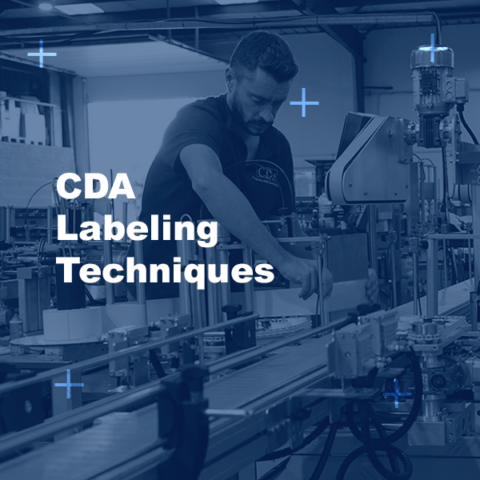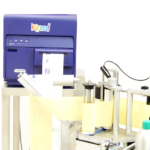Labeling holds a crucial role in the packaging sector, where every detail matters to ensure the final product’s quality. At CDA, experts in filling and labeling machinery, innovation is the cornerstone of our mission to cater to our customers’ requirements.
In this article, we delve into the various labeling methods employed by CDA and spotlight three commonly utilized approaches: ‘3-point,’ ‘banding,’ and ‘on-the-fly.’ We’ll also briefly touch on other existing methods and provide guidance on selecting the appropriate labeler.
The “3-point” Technique
The “3-point” technique stands as the most accurate labeling method. It suits cylindrical and conical products like bottles and flasks. This method involves product rotation (facilitated by a smoothing roller and a pressure plate cylinder). During rotation, one or more labels are dispensed and applied.
The merits of this technique encompass:
- Precision: The three support points ensure precise label placement, preventing any misalignment or wrinkling.
- Aesthetics: This technique offers unmatched versatility, allowing the application of up to four labels per container. It also excels on tapered products.
Banding
Banding entails rotating products using motorized bands that encase the container. Consequently, the label wraps around the container, smoothing its edges. This method is ideal for cylindrical products requiring a single label, often encircling the product.
Banding advantages include:
- Security and Protection: Banding can hermetically seal the product, shielding it from contamination or degradation.
- Time Efficiency: It permits high production rates, with no product halts, which proves vital in large-scale manufacturing environments.
“On-the-fly” Labeling
“On-the-fly” labeling is a technique for applying labels to continuously moving products, typically via a conveyor or starwheel. It proves exceptionally effective in high-speed production environments.
The benefits of “on-the-fly” labeling are:
- High Speed: Labels are applied to products without interruption, enabling swift production rates.
- Versatility: This technique is adaptable to cylindrical products as well as square, rectangular, oval, and various other shapes.
Other Labeling Techniques
In addition to the aforementioned techniques employed at CDA, alternative labeling methods cater to specific needs:
- Top-Bottom Labeling: Developed for simultaneous top and bottom labeling of products, this mechanism is primarily used for thin or flexible items that cannot be labeled on their sides, such as thermoformed trays commonly found in the food industry.
- Pressure-Sensitive Labeling: This technique suits heat-sensitive products, where the label is pressed onto the product for optimal adhesion.
CDA offers an extensive range of labeling machines, spanning from semi-automatic to automatic labelers. Our automatic machines can be equipped with “3-point,” “on-the-fly,” or “banding” systems. This wide selection enables us to address a diverse array of requirements.







